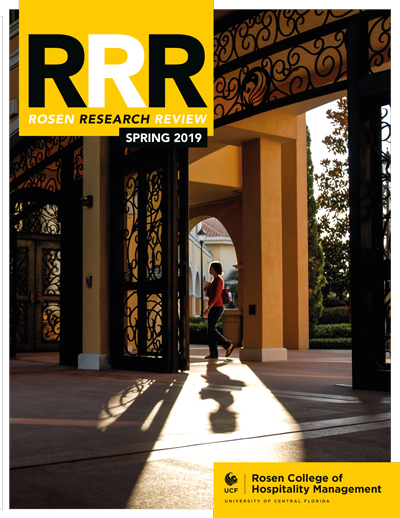Rosen Research Review: Help Yourself
 Are Self-Service Technologies Doing Enough to Elicit a Positive Response From Consumers?
Are Self-Service Technologies Doing Enough to Elicit a Positive Response From Consumers?
The use of self-service technologies (SSTs) has grown significantly over the last ten years. In their research paper, Dr. Wei Wei, Dr. Edwin N. Torres and Dr. Nan Hua from Rosen College of Hospitality Management, University of Central Florida, aim to identify gaps in current research into the value of SSTs within hotels and restaurants. They also look at the role extrinsic and intrinsic attributes play and how an SST can lead to a transcendent service experience (TSE).
We are all well used to self-service technologies (SSTs) within banking in terms of service tills and deposit machines and within retail with self-checkout. Less familiar is the rise in such technology within the hospitality industry where, for example, such devices can enable consumers to check in and out or order food for themselves. The aim? To make the process much faster and easier for guests.
As consumers, we are guided by both intrinsic and extrinsic motivations when making decisions. Extrinsic refers to the functional, and therefore tangible, factors involved. For example, we might choose a particular product because it will save us time. And as Kokkinou and Cranage (2015) found, in the hospitality industry, “consumers were more likely to embrace SSTs, as the waiting time for a service associate became longer”. Intrinsic motivations are slightly more complex in that they relate to the emotional, and therefore intangible, benefits. Perhaps we make a decision based on social image, or emotional value, because it will satisfy our curiosity or is relevant to the particular situation we are in. When it comes to the use of SSTs in a hospitality context, the Rosen researchers argued, this distinction is key.
Consumers, they suggested, respond differently to both intrinsic and extrinsic attributes of SSTs.
Photo: Marius Pirvu/Shutterstock.com
THE TRANSCENDENT SERVICE EXPERIENCE
When a customer interacts with an SST – such as to order food via a tablet device in a restaurant – this has the ability to empower and engage a customer and so enhance their experience. In so doing, this creates an opportunity for businesses to “capitalise on consumer experience (Bill Xu and Chan, 2010) by deliberately designing engaging experiences and creating memorable events that could generate economic value (Pine and Gilmore, 1998)”, cite Wei, Torres and Hua. Schouten et al. (2007) label this “the transcendent customer experience (TCE)”.
The researchers wanted to ‘reflect the service context’ of their study and so used the modified term ‘transcendent service experience’ (TSE). Because a TSE relates to a ‘peak’ experience, the researchers used it in the context of discovering the most memorable service experience. The researchers wanted to ‘reflect the service context’ of their study and so used the modified term ‘transcendent service experience’ (TSE). Because a TSE relates to a ‘peak’ experience, the researchers used it in the context of discovering the most memorable service experience.
Using an SST not only provides functionality to a consumer; it can also enhance service experience. SSTs can elicit emotional responses, create positive recollections and offer a unique experience. All of these are opportunities for businesses to leverage a competitive edge. For this reason, Wei, Torres and Hua are clear: the question for the hotel industry is now no longer whether to adopt SSTs but instead the focus is on how to use them to create a TSE.
PLUGGING THE GAPS
However, compelling research from a number of studies focusing on ‘technology anxiety’ (Collier and Sherrell, 2010), ‘waiting lines’ (Kokkinou and Cranage, 2015) and ‘functionality issues’ (Wang and Wang, 2010) has identified that consumer response to SSTs within the hotel industry has to this point been far from engaging. As Wei, Torres and Hua cite: “According to a survey conducted by American Hotel and Lodging Associations in 2011, only 10%–25% of hotel customers used kiosks to check in or out when such service was available and customers’ responses had been lukewarm or unfavorable in those hotels that had removed traditional front desk.”
Wei, Torres and Hua also identify three gaps in SST research. These were the areas of hospitality; consumer attitude and willingness to use such technology; and how SST usage impacts on the wider service experience within hospitality. They set out to examine whether the extrinsic and intrinsic factors affected consumer satisfaction with SSTs and what impact they had on the overall TSE.
SHAPING THE RESEARCH
A survey was sent to 220 hotel and restaurant customers, being first sent to a panel of three senior researchers for feedback. Amazon Mechanical Turk (MTurk) helped find participants who matched the criteria of being aged 18+ and having used an SST in a hotel or a restaurant context in the past 12 months. The survey had four distinct parts: the background of the participants’ most memorable SST recollection; the participants’ subjective SST experience; the participants’ TSE at the recalled encounter; and demographical information.
The study identified that both extrinsic and intrinsic attributes impact the success of an SST, while the lure of saving time and offering convenience – extrinsic values – are key consumer satisfaction drivers. As such, extrinsic attributes have a greater role to play when evaluating the consumer satisfaction level of using an SST.
The research also found that intrinsic benefits have a more significant impact on consumers’ views of SSTs than previously thought. However, the team explain that, while the “impact of the intrinsic attributes of SSTs on satisfaction with SSTs was found to be positive and significant in a restaurant setting, such impact in a hotel setting was positive and insignificant”. Therefore, extrinsic factors are the driving force behind consumer satisfaction with SSTs.
INFLUENCING TSE
Interestingly, however, the research also highlights that, in terms of TSE, customers are much more swayed by intrinsic attributes while, conversely, extrinsic values have a negative impact. The researchers attribute the likely rationale for this to two possibilities:
- Consumers are becoming familiar with the convenience and time saving factors associated with Rather than making an experience memorable, such extrinsic attributes have instead become an expected (and mundane) part of the experience.
- TSE involves the creation of a memorable, unique So, the intrinsic aspects of the experience therefore become more important. As the team explains: “The extrinsic attributes associated with SSTs are utilitarian in nature, thus are likely to provide the wrong benefits for those who are seeking TSE.”
IMPLICATIONS FOR INDUSTRY
The research highlights how the hospitality sector can enhance a customer’s overall satisfaction by ensuring an SST is closely aligned to a customer’s needs, giving a much more personalized experience and contributing to TSE. As the authors point out, the main question for businesses is how – and not whether – “to best leverage SSTs to create a better customer experience”.
Furthermore, due to the already identified negative influence of SSTs’ extrinsic attributes for hotel guests’ TSE, the hospitality industry may be better served by improving “the uniqueness of SSTs’ extrinsic attributes at service encounters”, states the team. For example, a guest could use an SST to ask room service to collect a tray or housekeeping for cleaning services. They could also use an SST to contact a specific manager directly.
In so doing – and by empowering and engaging the customer – the hospitality industry has the tools to create a more personalized experience. As Wei, Torres and Hua cite: “Such service customization was found to further lead to higher customer satisfaction (Ding and Keh, 2016). And by creating SSTs that emphasize entertainment and satisfy customers’ curiosity, managers will have a better chance of staging TSE.” By examining the effect of intrinsic and extrinsic attributes separately, the researchers have been able to give a new insight into the benefits of SST use in the hotel and restaurant industry.
 Dr. Wei Wei is an Assistant Professor at Rosen College of Hospitality Management, University of Central Florida. Her research interests include consumer behavior, psychology, and experience with a focus on consumer-to-consumer interactions, consumer engagement behavior, and consumer experience with emerging technologies.
Dr. Wei Wei is an Assistant Professor at Rosen College of Hospitality Management, University of Central Florida. Her research interests include consumer behavior, psychology, and experience with a focus on consumer-to-consumer interactions, consumer engagement behavior, and consumer experience with emerging technologies.
A: 9907 Universal Blvd., Orlando, FL 32819
E: Wei.Wei@ucf.edu T: +1 (407) 903 8230
W: https://hospitality.ucf.edu/person/wei-wei/

Dr. Edwin N. Torres is an Associate Professor at Rosen College of Hospitality Management, University of Central Florida. Prior to his current role, Dr. Torres received a Ph.D. from Purdue University. His research, which focuses on consumer psychology, has been published in multiple scholarly journals and presented in multiple conferences.
A: 9907 Universal Blvd., Orlando, FL 32819
E: edwin.torres@ucf.edu T: +1 (407) 903 8103
W: https://hospitality.ucf.edu/person/edwin-torres/
 Dr. Nan Hua (PhD) is an Associate Professor of hospitality management in Rosen College of Hospitality Management at University of Central Florida. His areas of research interest include performance and intangible asset evaluation and analysis in the hospitality and tourism industry.
Dr. Nan Hua (PhD) is an Associate Professor of hospitality management in Rosen College of Hospitality Management at University of Central Florida. His areas of research interest include performance and intangible asset evaluation and analysis in the hospitality and tourism industry.
A: 9907 Universal Blvd., Orlando, FL 32819
E: nan.hua@ucf.edu T: +1 (407) 903 8095
W: https://hospitality.ucf.edu/person/nan-hua/
Researchers in Focus
Research Objectives
This paper from Wei, Torres and Hua examines how self-service technologies can improve customer satisfaction, ultimately leading to a transcendent service experience.
References
Key paper
Wei W, Torres, E and Nan H. (2017) The power of self-service technologies in creating transcendent service experiences: The paradox of extrinsic attributes. International Journal of Contemporary Hospitality Management, Volume 29 Issue: 6, 1599-1618. Available at: https://doi. org/10.1108/IJCHM-01-2016-0029
Additional references
Bill Xu, J and Chan, A (2010). A conceptual framework of hotel experience and customer-based brand equity: some research questions and implications. International Journal of Contemporary Hospitality Management, Volume 22 No. 2, 174-193.
Collier, J and Sherrell, D (2010). Examining the influence of control and convenience in a self-service setting. Journal of the Academy of Marketing Science, Volume 38 No. 4, 490-509.
Ding, Y and Keh, H (2016). A re- examination of service standardization versus customization from the consumer’s perspective. Journal of Services Marketing, Volume 30 No. 1, 16-28.
Kokkinou, A and Cranage, D (2015). Why wait? Impact of waiting lines on self-service technology use. International Journal of Contemporary Hospitality Management, Volume 27 No. 6, 1181-1197.
Pine, B and Gilmore, J. (1998). Welcome to the experience economy. Harvard Business Review, Vol. 7 No. 4, 97-105.
Schouten, J, McAlexander, J and Koenig, H. (2007). Transcendent customer experience and brand community. Journal of the Academy of Marketing Science, Volume 35 No. 3, 357-368.
Wang, H and Wang, S (2010). Predicting mobile hotel reservation adoption: insight from a perceived value standpoint. International Journal of Hospitality Management, Volume 29 No.
Personal Responses
What is the key take-home for industry from this research and what is the next stage of research leading on from this?
This research helps hotel and restaurant practitioners to gain a deeper understanding of how various characteristics of SSTs contribute to consumer satisfaction with SSTs and transcendent service experiences. Effective strategies are recommended to expand the role of SSTs in the hotel and restaurant sector beyond extrinsic attributes to satisfy consumers’ curiosity, foster customer–customer interactions, and personalize consumer experience.
Future studies should examine whether SST experience would vary with different demographic groups. As SSTs are becoming increasingly prevalent in daily life, longitudinal studies are also recommended to explore how the tested relationships may change over time.

